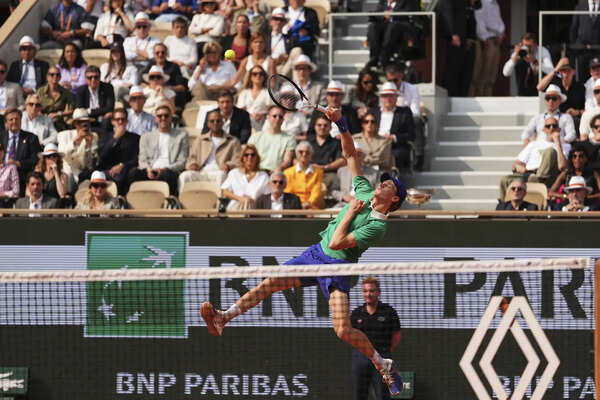ARTICLE AD BOX

Spain's Carlos Alcaraz (right) and second placed Jannik Sinner of Italy pose with trophies after the final match of the French Tennis Open at the Roland-Garros stadium in Paris, Sunday, June 8, 2025 (Image via AP /Thibault Camus)
In A Complete Unknown, folk singer Pete Seeger tells an audience: “A few months back, my friend Woody Guthrie and I met a young man who dropped in out of nowhere and played us a song. In that moment, it felt like we got a glimpse of the future.
”That young man was Bob Dylan, who didn’t just change folk music but transcended the traditional barriers of space, time, and language with his craft—to the point that he became the first songwriter to win the Nobel Prize for Literature. On June 8 in Paris, two young men, both born after Y2K, also gave us a glimpse of the future—a post-Federer-Nadal-Djokovic future of tennis.
A COMPLETE UNKNOWN | Official Teaser | Searchlight Pictures
But let’s back up a little to 2003, when Andy Roddick won the US Open after beating Juan Carlos Ferrero (now immaculately ageing like fine wine in Carlos Alcaraz’s corner).
He thought he was on the verge of a big innings, the new Great American Hope after Messrs Sampras and Agassi. Except, a classy gentleman from Switzerland, a bullish young man from Spain, and a gluten-free cyborg from Serbia had other ideas.In fact, for the next two decades, only 11 other men bothered the record keepers at Wimbledon, Flushing Meadows, Roland Garros and Melbourne Park.
But under the Parisian sun, on the burnt orange soil of Roland Garros, we saw a new kind of final play out.
One that didn’t just hark back to a glorious past but portended a new kind of future.Carlos Alcaraz and Jannik Sinner, two men not old enough to rent cars in some countries, produced a match for the ages: 5 hours and 29 minutes of court sorcery, athletic defiance, and generational transition.
The Five-Set Epic
Alcaraz and Sinner have been on a collision course for a while. Both had perfect records in Slam finals: Alcaraz 4 out of 4, Sinner 3 out of 3.
They had met in quarters and semis before, but never in a Grand Slam final. Neither had come back from two sets down. Neither had survived a match over four hours. Something had to give, and it did in Paris.The 2025 French Open final didn’t start like an instant classic. In fact, it was slow, laborious and ponderous—more Breaking Bad pilot than Game of Thrones. Sinner broke Alcaraz early, playing with depth and discipline, pushing the Spaniard behind the baseline.
His backhand down the line—his Excalibur—sliced through Alcaraz’s defence. Set one, 6-3 Sinner. No nerves, no frills. In the philosopher Mick Jagger’s words, every saint is always a sinner and Sinner was a saint for the first thirty minutes.

Italy's Jannik Sinner plays a shot against Spain's Carlos Alcaraz during their final match of the French Tennis Open at the Roland-Garros stadium in Paris, Sunday, June 8, 2025. (AP Photo/Lindsey Wasson)
Set two was tighter. Alcaraz’s forehands grew heavier, but Sinner’s ice held. At 4-4 in the tiebreak, Alcaraz blinked, Sinner’s Iceman destroying Alcaraz’s Maverick. 7–6(4) Sinner.
Two sets to love.The coronation script was already being copy edited but much like a modern-day Tittivillus, Alcaraz decided to ruin the plot.In the third set, he slowed the tempo, mixed up his spins, and started pulling Sinner into angles that could be studied in geometry classes. He broke late and closed it 6–4. The first crack in Sinner’s Iceman act.Set four was the turning point of the match—and maybe the rivalry. Sinner served at 5–4, holding three championship points.That’s when Alcaraz became the sinner in chief, the Devil who believed that free will was more important than having a seat at the table of heaven.A disguised drop shot that made the audience gasp. A running forehand that hugged the tramline. A backhand pass that defied gravity and good manners.He saved all three. He broke. He held. And in the tiebreak? 7–6(3) Alcaraz. From two sets down, he’d levelled it. Now the match had teeth.By the fifth, it was pure survival. Both called trainers. Both cramped. Both dragged themselves across clay as if auditioning for a post-apocalyptic drama. The rallies slowed. The tension didn’t. They traded breaks, traded roars, traded mythologies.At 6–6, it came down to the super tiebreak. A ten-point sprint to tennis immortality. Alcaraz didn’t blink. Sinner did. 10–2. The match: 3–6, 6–7(4), 6–4, 7–6(3), 7–6(10–2).
A comeback for the ages. The longest Roland Garros final. The first time Alcaraz had come back from two sets down.A Study in Contrast

Italy's Jannik Sinner tosses his racket during the final match of the French Tennis Open at the Roland-Garros against Spain's Carlos Alcaraz in Paris, Sunday, June 8, 2025. (AP Photo/Aurelien Morissard)
The match was a masterclass in contrast. Alcaraz plays like a flamethrower in a Picasso studio—wild, dazzling, unpredictable. His forehand isn’t just fast—it’s early, angled, and deadly. His drop shots? Something even the Federer-Nadal-Djokovic troika never had to deal with.Sinner, by contrast, is all discipline and depth.
His forehand holds up admirably, but his backhand—flat, fast, and surgical—is the true menace. He takes Alcaraz’s spin and redirects it like a prism redirecting light. Even his drop shots, though fewer, are devastating—more assassin than artist.Where Alcaraz paints murals, Sinner solves equations with a scalpel. One plays to the gallery; the other to the gods of geometry. It is style versus structure. Swagger versus silence.
Alas one has to give but there’s no reason this is the end. If anything, it’s the beginning.
A Legacy Continues
There’s a funny thing in sports called the Barrier Effect—or to name it after its progenitor, the Roger Bannister Effect. When Bannister ran the first sub-four-minute mile in 1954, the world thought it was impossible. And then, it wasn't. Once the barrier broke, others stormed through.Watching Sinner and Alcaraz, it feels like they are – in a similar way – summoning the geniuses of Federer, Nadal, and Djokovic, the men who had almost redefined the art of playing tennis.The French Open had begun with a touching tribute to Rafael Nadal, where his greatest rivals turned up to pay homage. While one can employ many a Kipling-like phrase to describe Nadal, the most fitting was the epic Nike commercial that condensed his never-say-die insouciant essence into a single McEnroe line: “Is he going to play every point like that?”
Te emocionará: el anuncio de Nike que repasa la carrera de Rafa Nadal desde los 16 años I MARCA
That line, that ethos, hovered over Philippe-Chatrier like ancestral smoke, much like Kipling’s ‘If you can meet Triumph and Disaster and treat both Imposters the same’ hovers over Centre Court at Wimbledon.
And as the match wore on, you could see it in both men—the unwillingness to concede a single point, the refusal to blink, the sacred duty of competing to the brink.
I mean, you gotta remember this guy (Alcaraz) has defence and speed like Novak, if not more. He has feel like Federer, you could argue at times if not more. He has RPMs in pace like Rafa. You could argue maybe even more.
Andre Agassi (Career Grand Slam Winner)
They had watched the greats. Now they are channelling them. Novak Djokovic once said he saw in Alcaraz a mix of himself, Federer and Nadal. John McEnroe called Sinner “the most improved player on the planet.”On June 8, both men made the prophecy real. Like Seeger watching Dylan, we got a glimpse of the future. And it is going to be glorious. And even if it isn’t like Rick and Ilsa in Casablanca: We will always have Paris.



.png)
.png)
.png)
















 2 hours ago
3
2 hours ago
3









 English (US) ·
English (US) ·